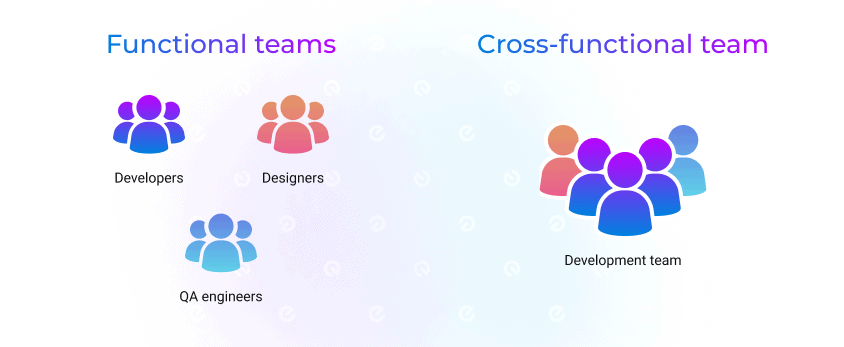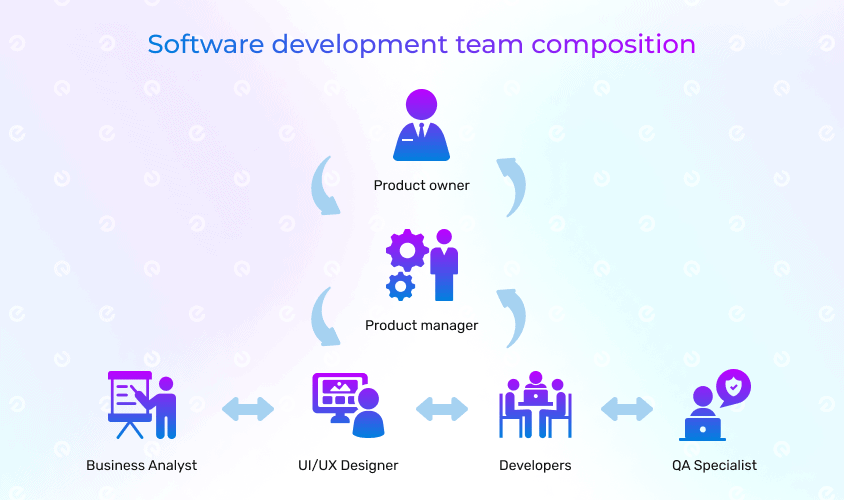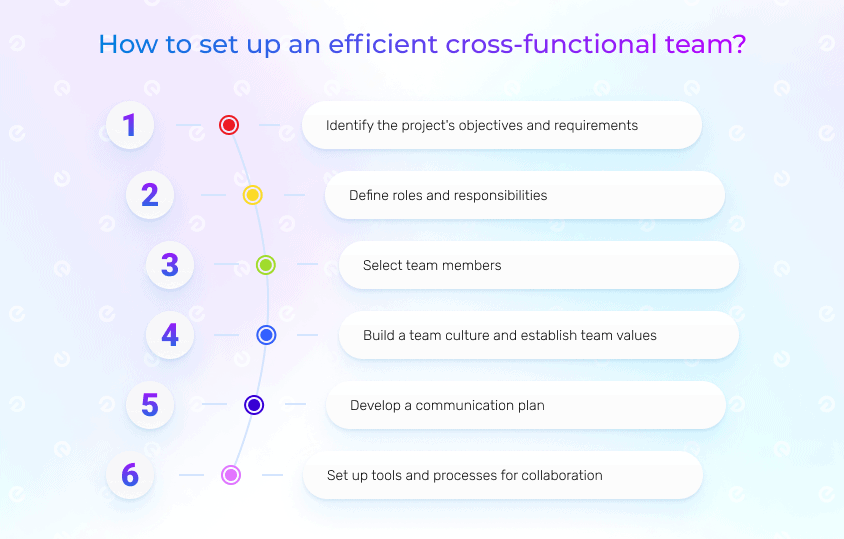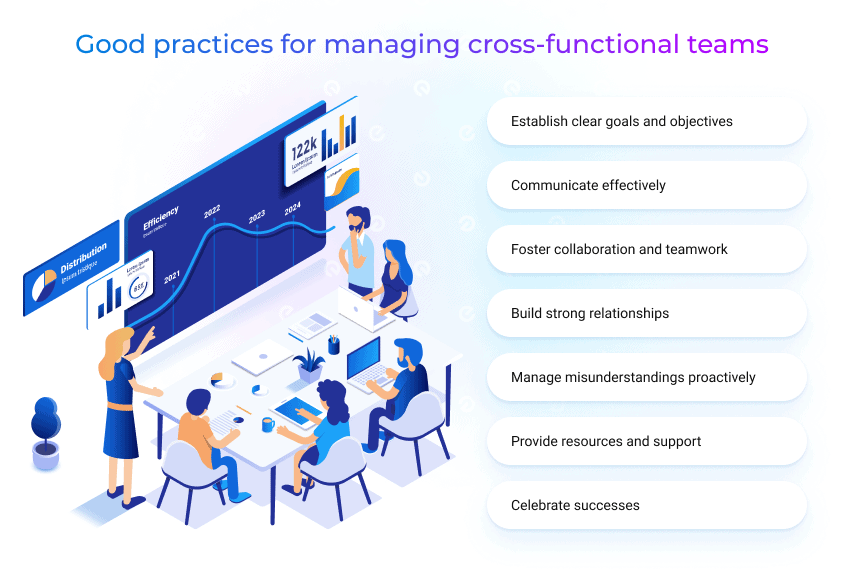
Updated: May 10, 2024
Published: March 28, 2023
Have you thought about the concept of a cross-functional team? What differentiates it from setting up traditional teams? How can it improve the software development process? In this article, we’ll discuss the characteristics of a cross-functional team, the benefits of having one, and how to build and manage such a team.
List of the Content
- What is a cross-functional team?
- Team composition in software development
- Benefits of a cross-functional team
- When does a business need a cross-functional team?
- How to set up an efficient team?
- Good practices for managing cross-functional teams
- Conclusion
WHAT IS A CROSS-FUNCTIONAL TEAM?
Software development is a complex and multifaceted process that requires the collaboration of individuals with different skills and expertise. To successfully deliver a high-quality software product, it’s essential to have a team that is diverse and cross-functional. As for the cross-functional team definition, it is a group of individuals with a range of skills, knowledge, and expertise working together to achieve a common goal. This type of team is essential in software development because it enables different perspectives to be considered, resulting in more comprehensive solutions and better outcomes.
What is a cross-functional team?
A cross-functional team is made up of individuals with different skills and areas of expertise who work together to achieve a common goal. What sets a cross-functional team apart from other types of teams is that it brings together people with diverse backgrounds and knowledge rather than relying on individuals who are specialized in one area.
In a software development context, a cross-functional team might include developers, designers, quality assurance testers, project managers, and other professionals with different skill sets. Each team member brings their unique perspective, experience, and expertise to the table, enabling them to identify and solve problems more effectively.
This requires a high level of collaboration, communication, and trust between team members. When a team works well together, it can deliver high-quality software products that meet the needs of all stakeholders.
In today’s business world, teams are an essential part of getting things done efficiently and effectively. It’s important to understand the difference between cross-functional and functional teams. Functional teams are composed of individuals with similar skills and job roles, while cross-functional ones bring together individuals from different functional areas to work on a specific project or goal. Both team types have their advantages and challenges, and organizations may use a combination of both to achieve their objectives.
While both types work towards achieving organizational goals, there is one distinctive difference in their level of specialization. Cross-functional teams are comprised of individuals with diverse backgrounds and skill sets. This diversity allows for a broader range of ideas and perspectives but may also require more communication and coordination to ensure that everyone is aligned and working towards the same goal.
Cross-functional teams are designed to bring together diverse perspectives and expertise to solve complex problems or tackle large-scale initiatives. For example, a product development team may consist of individuals from marketing, engineering, and operations who collaborate to create a new product from start to finish.
CROSS-FUNCTIONAL TEAM COMPOSITION IN SOFTWARE DEVELOPMENT
The purpose of this team is to bring together individuals with diverse skills and expertise to work collaboratively and more efficiently toward a common goal. Cross-functional teams in software development aim to enhance productivity and promote communication, collaboration, and transparency among team members.
They often follow agile methodologies, emphasizing collaboration, flexibility, and iterative development. In an agile environment, development teams work together to deliver software in small increments, allowing for continuous feedback and improvement.
Software development organizations can improve the quality of their products, reduce time to market, and increase customer satisfaction. Cross-functional teams also promote a culture of continuous learning and development, as team members are exposed to different perspectives and ways of working. Let’s consider some key roles to cover the team composition for software development. They need to be filled so as to ensure that the team is productive, efficient, and able to deliver high-quality software products. These roles typically include:
- The product owner defines the vision and ensures the development team builds the right product. They work closely with stakeholders and customers to identify and prioritize features and guide the team on what to build and when. They also ensure that the team is building the right product and that it aligns with the business objectives.
- The product manager takes responsibility for the overall success of the product. They need to work closely with the product owner and the development team to ensure that the product meets business goals and customer needs. They are also responsible for managing the product roadmap and making strategic decisions about its direction.
- The business analyst focuses on gathering and analyzing requirements from stakeholders and customers. They collaborate with the product owner and the development team to ensure the product meets the needs of all stakeholders, including customers, business users, and technical users.
- The UI/UX designer covers the tasks of designing the product’s user interface and user experience. They work closely with the product owner, business analyst, and front-end developer to ensure the product is easy to use, visually appealing, and meets user needs.
- The front-end developer is responsible for implementing the user interface of the product. They work closely with the UI/UX designer to ensure that the product is visually appealing, easy to use, and can be accessed to work on different devices. Besides, they collaborate with back-end developers and QA specialists to ensure that the front-end and back-end systems are integrated properly.
- The back-end developer aims to implement the server-side logic of the product. They work closely with the front-end developer to ensure that the product is scalable, secure, and performs well. They always work with the QA specialist to ensure the product is thoroughly tested.
- The QA specialist ensures the quality of the product. They work with the entire team to develop test plans and ensure that the product meets all requirements. They also identify defects and work with the development team to fix them.
Overall, these roles are critical to a cross-functional team’s software development success. Each role brings a unique perspective and skill set to the team, which helps ensure that the product is developed successfully and meets the needs of all stakeholders.
Looking for a dedicated development team?
At Existek, you can find your dedicated team to start the project when leveraging great expertise, focusing on quality, and gaining flexibility.
BENEFITS OF A CROSS-FUNCTIONAL TEAM
We’ve found that cross-functional teams are groups of individuals from different departments or areas of expertise who work on a specific project or objective. It’ll be interesting to discover what benefits of a cross-functional team businesses can get:
Diverse perspectives: One of the primary benefits of a cross-functional team is that they bring together individuals with different backgrounds, skill sets, and experiences. This diversity can lead to more creative and innovative solutions to problems. For example, a team made up of engineers, designers, and marketers might approach a project in very different ways. Still, the combination of their perspectives can lead to a more well-rounded and effective solution.
Improved communication: Effective communication is critical for any team to succeed, but it’s especially important for cross-functional teams, which may include individuals from different departments or even different companies. When team members need to communicate across functional boundaries, they must learn to be clear and concise, avoid technical language that others may not understand, and work together to find common ground. This can improve overall communication skills and create a more cohesive team.
Increased efficiency: Teams can be more efficient than traditional teams because they allow for better coordination and collaboration across departments. Instead of little interaction between different departments, teams continuously collaborate to stay on the same page and work towards the same goals. This can lead to faster decision-making, fewer delays, and a more streamlined workflow.
Enhanced problem-solving: They can solve problems more effectively because they have access to a wider range of knowledge and expertise. When a problem arises, team members can draw on their own expertise and the experience of their colleagues to identify potential solutions. They can also identify and address issues more quickly because they have a more comprehensive understanding of the problem at hand.
Professional development: Cross-functional collaboration provides opportunities for individuals to learn new skills and expand their knowledge base. By working with others outside of their traditional roles, team members can gain exposure to different aspects of the business and develop a more well-rounded skill set. For example, an engineer working in a cross-functional team might learn more about marketing or design, while a marketer might learn more about engineering or product development. That can benefit not only the individual team members but also the company as a whole, as employees become more versatile and better equipped to take on new challenges.
WHEN DOES A BUSINESS NEED A CROSS-FUNCTIONAL TEAM?
Cross-functional teams can be particularly useful in software development, where different functional areas need to collaborate to produce high-quality software. Here are some common use cases in software development where a business may need to engage a cross-functional team:
- Product development: It’s a common practice to form a cross-functional team to develop new products or features. These teams can include software developers, designers, quality assurance testers, and product managers. By bringing together individuals with different areas of expertise, the team can develop software that meets user needs and is technically feasible. It ensures that all aspects of the product, from design to manufacturing to marketing, are considered and integrated.
- Agile development: It’s surprising that they are also essential to Agile development methodologies, such as Scrum. In Agile development, teams are self-organizing and cross-functional, with members responsible for different aspects of the development process, such as development, testing, and project management.
- DevOps: The purpose of DevOps practices is to integrate development and operations teams to improve the quality and speed of software delivery. DevOps teams typically include software developers, operations engineers, and quality assurance testers.
- Complex problem-solving: When a business faces a complex problem requiring input from different functional areas, a team can be formed to bring together the necessary expertise and perspectives to find a solution.
- Process improvement: Establishing such teams can also be used to improve business processes. By bringing together individuals from different functional areas, the team can identify inefficiencies in the current process and develop solutions to streamline it.
- New market entry: When a business is looking to enter a new market, a cross-functional team can be formed to research the market, identify the target audience, and develop a strategy for entering the market.
- Strategic planning: These teams can also be useful in strategic planning. They can develop a comprehensive and well-rounded plan for achieving the business’s goals by bringing together individuals with different perspectives and expertise.
Therefore, such teams become inevitable for software development. It’s always useful when a business brings together individuals with different skills and expertise to solve a complex problem, develop a new software product, or engage in strategic planning.
Would you like to create a sophisticated software solution for your business?
Feel free to contact Existek. We’re a software development company with first-hand experience in providing full-cycle services. We offer a wide range of services, from custom development to dedicated teams to address your business-specific needs.
HOW TO SET UP AN EFFICIENT CROSS-PLATFORM TEAM?
That’s one of the common questions to address when starting software development. We’ve gathered several key steps that should be taken to simplify this process. These steps are designed to ensure that the team is organized, focused, and able to work together in a way that maximizes productivity and quality.
- Identify the project’s objectives and requirements
Before assembling a cross-functional team, it’s important to identify the objectives and requirements of the project. It includes the scope of the project, the timeline, and the expected outcomes. By understanding these requirements, you can ensure the team is focused on the right goals and has a clear sense of direction.
- Define roles and responsibilities
Once you have identified the project’s objectives and requirements, you need to define the roles and responsibilities of each team member. This includes identifying the skills and expertise needed for each role, as well as the level of authority and accountability that each team member will have.
- Select team members
Choosing the right team members is crucial for the success of a cross-functional team. Look for individuals with complementary skills and diverse backgrounds who can work well together. It’s also important to ensure that team members have the right level of experience and are committed to the project.
- Build a team culture and establish team values
A strong team culture means establishing team values that everyone can buy into and creating an environment of trust and respect. It’s important to encourage open communication, collaboration, and a shared sense of purpose.
- Develop a communication plan
Effective communication is critical for this type of team. Develop a plan that outlines how team members will communicate with each other, what tools and platforms will be used, and how often communication will occur. Make sure that team members understand the plan and are comfortable with the tools and platforms being used.
- Set up tools and processes for collaboration
It always remains essential for cross-functional team examples so that they can work together effectively. Therefore, it includes selecting project management software, defining workflows and processes, and establishing guidelines for how team members will work together.
- Provide ongoing training and development opportunities
Finally, provide ongoing training and development opportunities to help team members stay up to date with the latest technologies and best practices. This will help ensure that the cross-functional team is able to work efficiently and effectively over the long term.
GOOD PRACTICES FOR MANAGING A CROSS-FUNCTIONAL TEAM
Managing a cross-functional team involves coordinating the efforts of individuals with different backgrounds, skills, and priorities. Let’s collect good practices for managing a cross-functional team:
- Establish clear goals and objectives: It’s important to have a shared understanding of the project’s goals and objectives to ensure everyone is working towards the same outcome. Clarify the scope of the project and define realistic timelines for completion.
- Communicate effectively: Communication is essential for managing a cross-functional team. Regular team meetings, status updates, and communication tools can keep everyone informed of progress, challenges, and changes to the project.
- Foster collaboration and teamwork: Encourage team members to work together and share their knowledge and expertise. This helps to create a culture of trust and respect among team members.
- Build strong relationships: Get to know each team member individually and understand their strengths, weaknesses, and motivations. Building strong relationships can improve team dynamics, morale, and productivity.
- Manage misunderstandings proactively: Conflicts and misunderstandings may arise in a cross-functional team due to differences in opinions or priorities. Be proactive in identifying and resolving such situations before they escalate. Encourage open communication and collaboration to find solutions that work for everyone.
- Provide resources and support: Ensure team members have the resources and support they need to perform their roles effectively. This includes access to training, tools, and technology.
- Celebrate successes: Celebrating successes and acknowledging individual contributions can increase productivity and motivate team members to continue working towards the project’s goals.
As a result, managing a cross-functional team requires effective coordination, communication, and collaboration among team members from different functional areas.
CONCLUSION
It’s always possible to create a team that is organized, focused, and able to work together in a way that maximizes productivity and quality. It just requires careful planning and attention to detail when setting up an efficient cross-functional team in software development. With good practices in place, you can create a team that is well-equipped to tackle any software development project and deliver outstanding results. Ultimately, cross-functional teams are essential for success in software development, and investing the time and resources to create a strong team will pay off in the long run.
How would you set up your professional team?
You can always apply for the services of professionals. Existek is a software development company to provide full-cycle services and build your efficient team to start the project.
Frequently asked questions
What is a cross-functional team?
That is a group of individuals from different functional areas, such as developers, designers, quality assurance engineers, project managers, and business analysts, who work together to develop, test, and deliver software products.
What are cross-functional team members for software development?
In order to start the software development process from scratch, the team has to include the following:
Product owner
Product manager
Business analyst
UI/UX designer
Back-end and front-end developers
QA specialist
Why do businesses need cross-functional teams in software development?
Businesses choose this type of team because they bring together diverse skill sets and perspectives to solve complex problems, improve communication and collaboration, increase innovation and efficiency, and ultimately deliver better products and services to customers.
What are cross-functional team benefits?
It includes the following benefits:
Diverse perspectives
Improved communication
Increased efficiency
Enhanced problem-solving
Professional development





